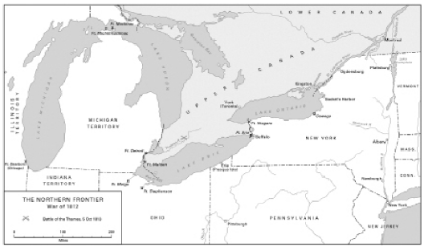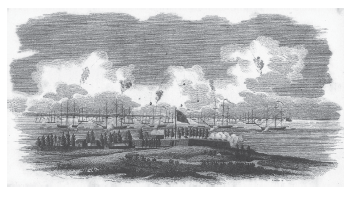It’s undeniable that the War of 1812 marked a shift in American history. The war is notable not only because it changed America’s place in the global marketplace, but because a young America fought the country with the greatest naval power in the world. America’s will to expand its territory was challenged in a war that was carried out through a series of potentially devastating battles. Here, we’ve collected five of the most pivotal battles from the War of 1812.
Battle of Lundy’s Lane
The victor in the Battle of Lundy’s Lane remains up for debate. The United States had been working to capture British-controlled Canada, and American Major General Jacob Brown successfully attacked at the Battle of Chippewa in July 1814, but withdrew his troops to secure his supply lines before progressing further. British Major General Phineas Riall sent troops along Lundy’s Lane to keep in contact with moving America forces. A British Lieutenant Governor, Gordon Drummond arrived to take control, and when Brown began to move north, Drummond countered Riall’s order to withdrawal with one to engage.
The two sides fought until late into the night, but by midnight both sides were so badly devastated that they called a ceasefire. With leaders bearing critical wounds and ammunition running low, Brown finally ordered his men to retreat. British forces were successful in preventing further advances by American troops, but high casualties on both sides made the battle devastating for both British and Americans.
Battle of Crysler’s Farm

The Battle of Crysler’s Farm was a failed attempt by the Americans to capture Montreal. It marked the end of the St. Lawrence Campaign, which was a series of efforts by the United States to take control of St. Lawrence river area. In November 1813, American troops were still moving north, but Brigadier General Joseph Morrison had a plan, and set up his forces in the center of a field belonging to the loyalist John Crysler. American troops saw this as an opportunity and attacked, which was exactly what Morrison had expected.
On the morning of November 11, the two sides engaged at Crysler’s Farm. Americans were weakened by being forced to traverse two ravines to reach the battlefield while the British had the upper hand by having selected the battleground and therefore could better strategically place their soldiers. The British received backup from Captain William Mulcaster, which forced American soldiers into a state of disarray. With their ammunition was running low and soldiers were falling in vast numbers, the Americans retreated the battle and were forced back to New York for the winter, relinquishing any hold they had on the area.
Battle of Queenston Heights
The Battle of Queenston Heights was the first major battle fought during the War of 1812. It was an early attempt by Americans to gain hold of British terrain just over the Canada border. They began crossing the Niagara River on October 13, but encountered British artillery fire from the opposite side of the river. American forces managed to cross the river, but were trapped at the base of the river bank under heavy fire.
Isaac Brock, a well-respected British Major General, led the attack on American forces that forced Americans further into the river. However, the general was killed by a musket ball, a devastating loss for the British. When the battle ended, U.S. forces were trapped in the woods against the river bank and with nowhere else to turn, surrendered. It was an embarrassing defeat for the Americans, but it was arguably the British who suffered worse with the loss of Brock.
Battle of Baltimore

For three days in early September 1814, British and U.S. forces collided in the fiercely anti-British city of Baltimore. It was because of this sentiment that city leaders expected an attack from the British. Along the outskirts of the city, Baltimore residents built a massive trench to defend the harbor, along with improvements at Fort McHenry. As expected, 3,000 British soldiers landed at North Point and progressed toward Hampstead Hill, where 12,000 Americans were waiting.
The next morning, the British made a move to capture Fort McHenry. They hoped an attack on the fort would cause Americans to panic and thus retreat, but what they didn’t know was that U.S. soldiers were waiting. Upon arrival, British forces were met with heavy gunfire and realized they were vastly outnumbered. Very soon the British began their retreat. From Fort McHenry, they sailed down to North Point where they met their fellow soldiers who had also retreated. The Battle of Baltimore was over, and the city was safe.
Battle of Stoney Creek
In the summer of 1813, the Battle of Stoney Creek was a turning point in the War of 1812. U.S. Major-General Henry Dearborn had recently captured Fort George during his campaign to gain hold of region along the New York-Canada border. He was prepared to launch a steady advance toward Upper Canada. Dearborn met his troops with another under the command of Brigadier Chandler and began their march toward Stoney Creek. A young local named Billy Green saw the American troops headed toward the creek, and raced to British forces at Burlington to inform them.
The British attacked under the cover of night. They bayoneted the sentries before they could alert that the enemy was approaching. The battle that ensued was chaotic and bloody. It had been a risky venture by British forces, but proved a successful one. 23 were killed on the British side, while 55 American soldiers were killed. Americans retreated back to Fort George with the range of movement in the Upper Canada region now severely limited.
The battles throughout the War of 1812 tested the strength and resilience of both American and British soldiers. With thousands of lives lost and countless others impacted, the war was destructive on more than one front. Today, visitors can walk many of the battlefields that have been preserved.

